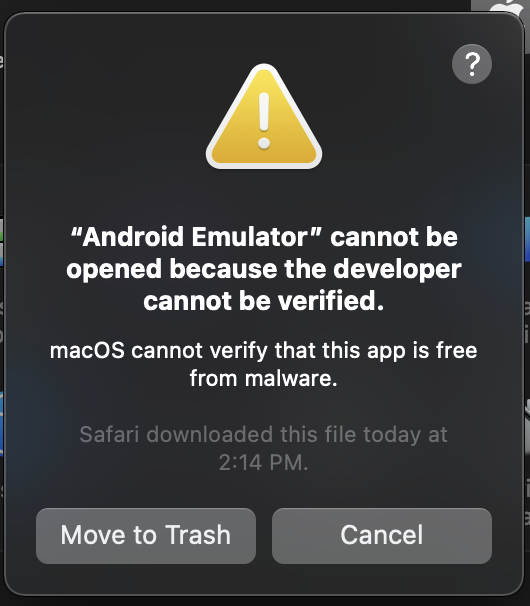- Android Studio Apple M1 Emulator
- Mac M1 Android Emulator
- Android Emulator Mac M1 Download
- Mac M1 Android Emulator Online
- Mac M1 Android Simulator
- Mac M1 Android Emulator No Internet
Using Android Studio Emulators in M1 Mac:
- Android emulator on Mac M1 You’re now watching this thread and will receive emails when there’s activity. Click again to stop watching or visit your profile/homepage to manage your watched threads.
- The emulator works great, its super fast, so much more than what I have used in my windows machine. And regarding the full screen halt its due to macos big sur. Had that issue on my old mac. Run this command on the terminal and it wont happen again defaults write com.google.android.studio AppleWindowTabbingMode manual.
Previously, when M1 Macbooks were released, Android studio didn’t have any support for emulators. Google has released a different preview build for emulators. You can check this build here.

Here are some of the best Android emulators for Mac. Bluestacks is one of the most popular Android emulators for Windows and is probably the best Android emulator for macOS, as well. This emulator is built primarily for mobile gamers and claims to provide a “PC-like” gaming experience for your mobile apps.
The problem with this preview build is that you can’t change the emulator device type. It works, but if you want to test your application on different device or different screen sizes, there was no other option available.
Recently, they released one change to the Android Studio SDK manager and downloading an extra emulator is no loger needed now.
In this post, I will quickly show you how to create Android Emulators on M1 chipset mac in Android Studio.
How to do that:
First, make sure that you have the latest Android Studio installed. If you have 4.1.2 or later Android studio version, this will work.
First, start AVD manager. If you haven’t created any AVD or android virtual device before, you will find it in Tools->AVD Manager.
Click on Create new virtual device button. It will show you a list of different devices. You can select any of these phones.
- Click on next. It will show you a list of system images. Basically, it shows different images for different Android Versions that can be used with the current AVD. Make sure to select the ‘Other image’ tab. Images listed under this tab are designed for Macbook M1.
That’s all. It will create one emulator using that selected image. You can also create different virtual devices using the same image.
M1 Macbookを使っている方はFlutterの環境構築でAndroidエミュレータが使えなくて焦ったと思います。
私もまだまだ初心者なので色々と拙いですが、よろしくおねがいします。
M1macじゃなければ動くように設定できている前提で進めます。

(面倒だったら挫折する前にiOSで開発を進めちゃうのでも全然良いと思います。)

M1 Macbookではエミュレータが使えないということで、2020年の12月頃にGoogleがAndroidのデモ操作をできるパッケージを提供しました。
そのパッケージを使うことでAndroid Emulatorというアプリをダウンロードして起動してデモ操作ができるようになりました。
そして2021年3月頃に、そのパッケージは必要なくなりました。Android Studioでエミュレータが起動できるようになったからです。
その方法を解説します。
Android Studio Apple M1 Emulator
まず画面右上の辺りからAVD Managerを開き、 Create Virtual Device...を開きます。
Mac M1 Android Emulator
適当に選択します。
次にOther Imagesの欄に移動してください。
私は既にダウンロード済みになっていますが、 API Level30辺りを適当に選択して、ください。
大事なのはABIがarm~となっているやつです。このarmがついているのを選択するとM1でも利用できるようになるみたいです。(まだまだ作業は続きます)
Nextを押してダウンロードを進めていってください。

ダウンロードが完了して開こうとすると、The emulator process for AVD was killed と出てエミュレータは開けないでしょう。
Android Emulator Mac M1 Download
ここで一度API Levelがダウンロードしたエミュレータと同じものを利用できるようになっているかチェックしてみてください。
Mac M1 Android Emulator Online
次に、
./Library/Android/sdk/emulator/darwin-aarch64-replace.sh
のdarwin-aarch64-replace.shを起動してください。
起動の仕方はTerminalでemulatorディレクトリまで移動した後に、
Mac M1 Android Simulator
これで
emulator-darwin-aarch64-0.2.zip
がダウンロードされているはずです。このファイルをクリックすると emulator-darwin-aarch64-0.2
というファイルが生成されます。
emulator-darwin-aarch64-0.2を開いて中身を全てemulatorファイルに移してください。
Mac M1 Android Emulator No Internet
そしてAVD Managerを開くと
<参考記事>
https://github.com/google/android-emulator-m1-preview/issues/34